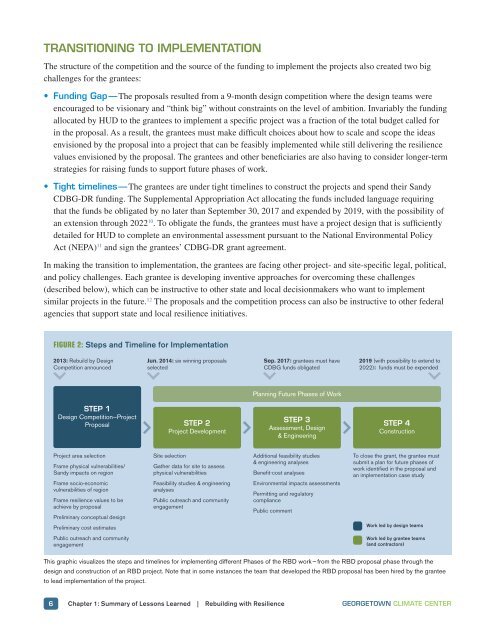Rebuilding with Resilience
dw0r306aHfX
dw0r306aHfX
Create successful ePaper yourself
Turn your PDF publications into a flip-book with our unique Google optimized e-Paper software.
TRANSITIONING TO IMPLEMENTATION<br />
The structure of the competition and the source of the funding to implement the projects also created two big<br />
challenges for the grantees:<br />
• Funding Gap — The proposals resulted from a 9-month design competition where the design teams were<br />
encouraged to be visionary and “think big” <strong>with</strong>out constraints on the level of ambition. Invariably the funding<br />
allocated by HUD to the grantees to implement a specific project was a fraction of the total budget called for<br />
in the proposal. As a result, the grantees must make difficult choices about how to scale and scope the ideas<br />
envisioned by the proposal into a project that can be feasibly implemented while still delivering the resilience<br />
values envisioned by the proposal. The grantees and other beneficiaries are also having to consider longer-term<br />
strategies for raising funds to support future phases of work.<br />
• Tight timelines — The grantees are under tight timelines to construct the projects and spend their Sandy<br />
CDBG-DR funding. The Supplemental Appropriation Act allocating the funds included language requiring<br />
that the funds be obligated by no later than September 30, 2017 and expended by 2019, <strong>with</strong> the possibility of<br />
an extension through 2022 10 . To obligate the funds, the grantees must have a project design that is sufficiently<br />
detailed for HUD to complete an environmental assessment pursuant to the National Environmental Policy<br />
Act (NEPA) 11 and sign the grantees’ CDBG-DR grant agreement.<br />
In making the transition to implementation, the grantees are facing other project- and site-specific legal, political,<br />
and policy challenges. Each grantee is developing inventive approaches for overcoming these challenges<br />
(described below), which can be instructive to other state and local decisionmakers who want to implement<br />
similar projects in the future. 12 The proposals and the competition process can also be instructive to other federal<br />
agencies that support state and local resilience initiatives.<br />
FIGURE 2: Steps and Timeline for Implementation<br />
2013: Rebuild by Design<br />
Competition announced<br />
Jun. 2014: six winning proposals<br />
selected<br />
Sep. 2017: grantees must have<br />
CDBG funds obligated<br />
2019 (<strong>with</strong> possibility to extend to<br />
2022): funds must be expended<br />
Planning Future Phases of Work<br />
STEP 1<br />
Design Competition—Project<br />
Proposal<br />
STEP 2<br />
Project Development<br />
STEP 3<br />
Assessment, Design<br />
& Engineering<br />
STEP 4<br />
Construction<br />
Project area selection<br />
Frame physical vulnerabilities/<br />
Sandy impacts on region<br />
Frame socio-economic<br />
vulnerabilities of region<br />
Frame resilience values to be<br />
achieve by proposal<br />
Preliminary conceptual design<br />
Preliminary cost estimates<br />
Public outreach and community<br />
engagement<br />
Site selection<br />
Gather data for site to assess<br />
physical vulnerabilities<br />
Feasibility studies & engineering<br />
analyses<br />
Public outreach and community<br />
engagement<br />
Additional feasibility studies<br />
& engineering analyses<br />
Benefit-cost analyses<br />
Environmental impacts assessments<br />
Permitting and regulatory<br />
compliance<br />
Public comment<br />
To close the grant, the grantee must<br />
submit a plan for future phases of<br />
work identified in the proposal and<br />
an implementation case study<br />
Work led by design teams<br />
Work led by grantee teams<br />
(and contractors)<br />
This graphic visualizes the steps and timelines for implementing different Phases of the RBD work — from the RBD proposal phase through the<br />
design and construction of an RBD project. Note that in some instances the team that developed the RBD proposal has been hired by the grantee<br />
to lead implementation of the project.<br />
6 Chapter 1: Summary of Lessons Learned | <strong>Rebuilding</strong> <strong>with</strong> <strong>Resilience</strong> GEORGETOWN CLIMATE CENTER


